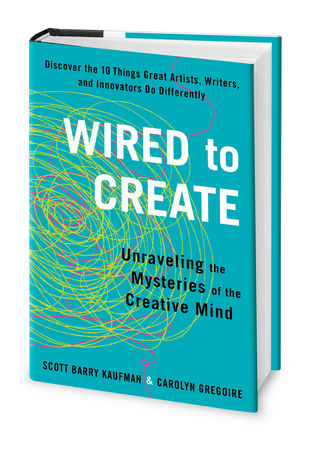Creativity
Adversity and the Creative Mind
How we find pathways through the impossible.
Posted January 18, 2016

Everyone experiences adversity, but some people use adversity to their psychological advantage. Do you?
As we age, we learn more about ourselves and how we cope with struggle and hardship. New research suggests creativity may play a key role in determining our ability to thrive in tough times.
We begin to grasp the role that adversity plays in our lives during early adolescence. By then, teens have witnessed the suffering of friends and family members. They have likely suffered themselves. As part of the teenage brain’s maturation process and search for identity, teens begin to recognize that people face and overcome adversity, fear, grief, and failure in many different ways. They also begin to understand that adversity can be devastating—leading to addiction, suicide, helplessness, and other misfortunes.
By the time we reach midlife, how we respond to adversity has become part of our DNA—for good or bad. We know how we react emotionally, intellectually, and physically to adversity. We have a personal history with adversity and know whether or not we are likely to come out on the other side with positive growth or depressed, defeated spirits. That said, it’s never too late to change our brains, thanks to our knowledge of neuroplasticity.
While most of us—young and old—fear adversity, research shows that up to 70 percent of people who overcome trauma report positive psychological growth (Linley & Joseph, 2004). Of course, the last thing someone wants to hear when they are experiencing trauma or loss is, “You’ll grow from this.” On the contrary, what we most want is for others to understand our pain and suffering, and not feel alone.
I reflected on my own history with adversity after a recent email from an old friend and mentor. “In my eyes,” she said, “you are the only person I know who can and does make lemonade out of life’s lemons. I really admire your ability to do that.”
Her comment took me by surprise. Did I tackle adversity any differently than other people? How have I survived and grown through some extremely difficult times in my life? As a developmental psychologist, her comment also prompted me to ask, “How do we best support young people as they struggle to understand and overcome adversity?”
What Doesn’t Kill Us Makes Us Stronger

I discovered some surprising answers to my questions in the book, Wired to Create: Unraveling the Mysteries of the Creative Mind, by Scott Barry Kaufman and Carolyn Gregoire. In it, they talk about the intimate connection between creativity and adversity. In fact, Kaufman and Gregoire dig into the many things that creative people do differently in their journeys through life. One of the attributes creative people possess is the ability to make meaning out of seemingly senseless suffering. The authors tell the story of artist Frida Kahlo to illustrate their point.
Kahlo found meaning from a number of traumatic experiences, including childhood polio, a near-fatal accident, and years of chronic pain, through the expressive act of painting. Her deepest pain became the inspiration for her creative work. Through her art, she experienced deep personal growth.
In an excerpt from their book, Kaufman and Gregoire state:
Art born of adversity is an almost universal theme in the lives of many of the world’s most eminent creative minds. For artists who have struggled with physical and mental illness, parental loss during childhood, social rejection, heartbreak, abandonment, abuse, and other forms of trauma, creativity often becomes an act of turning challenge into opportunity.
Much of the music we listen to, the plays we see, and the paintings we look at—among other forms of art—are attempts to find meaning in human suffering. Art seeks to make sense of everything from life’s smallest moments of sadness to its most earth-shattering tragedies. We all experience and grapple with suffering. In our individual and collective quest to understand the darker sides of human life, works of art like Kahlo’s self-portraits, which show us the truth of another’s pain and loneliness, carry the power to move us deeply.
We’re told, throughout our lives, that what doesn’t kill us makes us stronger. It’s difficult to think of a phrase that’s more deeply ingrained in our cultural imagination than this one, first spoken by Nietzsche and since co-opted by pop culture (think Kelly Clarkson and Kanye West). Platitude though it may be, the expression has become common parlance because it expresses a fundamental truth of human psychology: Experiences of extreme adversity show us our own strength. And in the wake of trying times, many people not only return to their baseline state of functioning, but learn to truly thrive.
As I read Kahlo’s story, I remembered how my own creativity helped me rebuild following my husband’s death, almost thirty years ago. I would play mind games with myself, trying to understand my suffering. As I walked through my neighborhood, I would envision how my life was like the pile of garbage I just passed by, including how I could be recycled. Or I’d see myself as a lonely, barren tree and how I would surely see new growth. I used metaphors to make sense of my grief. Amazingly, it worked for me.
Many times since, like when I faced cancer or the death of my parents, I turned to creative outlets like writing, metaphorical thinking, and walking alone in nature. We don’t have to be artists to be creative. I searched, in my own uniquely creative fashion, for ways to make meaning from my suffering. It’s become a habit—a familiar way my brain helps me through life.
After rethinking my friend’s comment about how I make lemonade out of lemons, I believe this common phrase is over simplified. Facing adversity is about becoming the lemon, then tenderly squeezing until you taste the sweetness of a fruit you once imagined was only sour. It’s about being creative in the face of fear and uncertainty.
Supporting Youth During Times of Adversity
Let’s return to the question, “How do we best support young people as they struggle to understand and overcome adversity?”
Kaufman and Gregoire would suggest we nurture their creativity. I wholeheartedly agree. In fact, many adolescents I’ve interviewed shared stories of how parents and/or teachers nurtured their creative expression as children and adolescents.
One teen shared how a teacher suggested he write about his struggle to accept his cultural differences and the adverse conditions of his childhood. This angry young man ended up finding his voice as a rapper. In the process, he found meaning in his suffering and went on to help others in similar circumstances.
In their book, Wired to Create, Kaufman and Gregoire share the latest research about the neuroscience of creativity and how our “messy minds” benefit us throughout life. You can also read an interview with the authors in an article at Psychology Today. A great read for everyone interested in the creative mind, I especially recommend this book for parents and teachers.
Lastly, there is another important way we teach young people to be resilient. We share our own stories of adversity. Instead of hiding our fears, failures, and vulnerabilities from young people, they need to know they are not alone in the struggle for meaning. There is no shame in adversity. In fact, overcoming adversity is one of the most profound and meaningful storylines in the book of life.
References
Kaufman, S. B. & Gregoire, C. (2015). Wired to Create: Unraveling the Mysteries of the Creative Mind. New York, NY: Perigee.
Linley, P. A., & Joseph, S. (2004). Positive change following trauma and adversity: A review. Journal of Traumatic Stress, 17(1), 11– 21.
Excerpt
Excerpted with permission from Wired to Create: Unraveling the Mysteries of the Creative Mind by Scott Barry Kaufman and Carolyn Gregoire. © 2015 by Scott Barry Kaufman and Carolyn Gregoire. A Perigee Book, an imprint of Penguin Random House LLC.
Author
Marilyn Price-Mitchell, PhD, is the author of Tomorrow’s Change Makers: Reclaiming the Power of Citizenship for a New Generation. A developmental psychologist and researcher, she works at the intersection of positive youth development and education.
Follow Marilyn's work at Roots of Action, Twitter, or Facebook. You can also subscribe to receive email notifications of Marilyn’s articles.
©2016 Marilyn Price-Mitchell. All rights reserved. Please see reprint guidelines for Marilyn’s articles.




